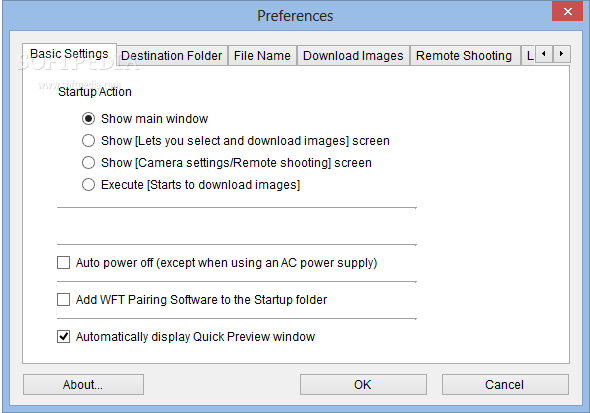
Download Wft Pairing Software Canon
Canon has a range of Wireless File Transmitter (WFT) units that can be fitted to many of its professional and semi-professional EOS DSLR cameras. These WFT units provide standard network wired or WiFi connections that allow a camera and remote computer to communicate and transfer images.
Brian Worley gives an overview of the Canon wireless system, network compatibility, and the best use of the communication modes within the Canon system. Each Canon WFT unit features three types of connection modes – WFT server mode, FTP transfer mode and EOS Utility – to suit different requirements for image transfer and remote camera control. Selecting the appropriate mode enables images to be sent continuously from the camera to a remote computer as the photographer shoots, or images can be selected for transfer by the photographer or a remote editor viewing images that are already stored on the camera’s memory cards. In some modes it is possible to remotely control the camera to change shutter speeds, apertures and other settings, including releasing the shutter over the network.
Due to the wide variety of network structures and network equipment the set-up of a WiFi transmitter requires knowledge of both the network environment and the EOS DSLR camera system. Wireless File Transmitters also have a 100Mbit wired network port that can be used instead of the WiFi connection.
(1) Self Cleaning Sensor Unit Removes dust adhering to the low-pass filter. Self-cleaning executed automatically (taking approx. Acer aspire windows 7 download. 2 sec.) when power is turned.
Wired networks deliver significantly faster data transfer speeds than WiFi networks and are sometimes used for arena sports photography where a set position is assigned. Wired connections are simpler to set-up than wireless ones, but the networking and software set-up processes are very similar. Network and connection options shown on a computer screen in Windows 7.
Wireless network terminology There are several key wireless-related terms that are worth knowing: • An Access Point is a hardware unit that provides a WiFi connection to a network system. It is sometimes referred to as a router. • An Internet Protocol (IP) address is a unique sequence of numbers that is used to identify a device on a network. IP addresses are written as a set of four numbers with a period between each.  Examples of IP addresses are 192.168.1.2 or 10.10.10.200 • The Service Set Identifier (SSID) is often called ‘the network name’ and is used to identify the WiFi network that’s being used for communication. • Domain Name Server (DNS): in networks connected to the internet the DNS enables the use of names to identify ftp servers, for example ftp.canon-europe.com instead of 192.168.1.2.
Examples of IP addresses are 192.168.1.2 or 10.10.10.200 • The Service Set Identifier (SSID) is often called ‘the network name’ and is used to identify the WiFi network that’s being used for communication. • Domain Name Server (DNS): in networks connected to the internet the DNS enables the use of names to identify ftp servers, for example ftp.canon-europe.com instead of 192.168.1.2.
The Domain Name Server maintains a cross reference of names and IP addresses. • Gateway – the network gateway is the unit that provides a connection route to networks outside of the directly connected devices.
A Gateway is often used to provide access to the internet. WiFi network types There are two types of WiFi network that Canon’s WFT units can use. Camera LCD screen showing the detected wireless Ad Hoc and Infrastructure (Infrastr.) wireless networks. Ad Hoc: to connect a camera directly to a computer. The term Ad Hoc is used to describe a simple network comprising of only two devices communicating with each other over a wired or wireless connection. Infrastructure: to connect to a larger network through an access point.
Although Ad Hoc networks are easier to set up, and simpler to implement, Infrastructure networks offer faster data transfer speeds and greater connection stability. Ad Hoc networks are used when there are no access points to connect, such as when shooting in remote locations, while an Infrastructure network is the best choice for studio work and can be set up through an access point. WFT communication modes Before the WFT unit is connected to a wireless network it's important to note that Canon’s range of Wireless File Transmitters provides several communication modes, each of which is suited to meet the needs of differing requirements. The modes, and their uses, are as follows: File Transfer Protocol (FTP) mode FTP is often used for transfer of binary and text files between different computer systems. In FTP mode an EOS camera connects to an FTP server and initiates the transfer of captured images to the FTP server.